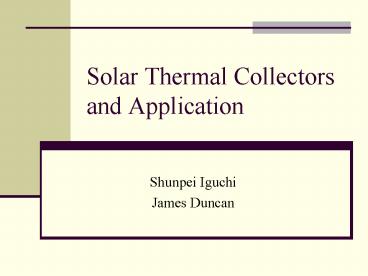Solar Thermal Collectors and Application PowerPoint PPT Presentation
1 / 36
Title: Solar Thermal Collectors and Application
1
Solar Thermal Collectors and Application
- Shunpei Iguchi
- James Duncan
2
(No Transcript)
3
Thermal Collector Mechanics
- Solar energy is absorbed, transformed, and
concentrated in a solar thermal collector over a
time or spatial gradient to produce usable energy
4
Thermal Collector Technologies
- Solar Cookers
- Parabolic Troughs
- Parabolic Dish
- Central Receiver System
- Solar Chimney
- Solar Distillers
- Solar Water Heaters
5
(No Transcript)
6
Solar Cookers
- Solar cookers or ovens are primarily used in
developing nations as a primary method for
cooking using passive solar heat to cook primary
meals - Insulated box that collects solar radiation
enhanced by reflectors attached to each side - Helps combat deforestation
7
Solar Oven in Nepal
8
Parabolic Trough
- A parabolic trough concentrates sunlight along a
spatial gradient into a linear focal point - A fluid acts as a thermal sink as it passes
through dewar tubes along the focal point - Parabolic troughs are used to generate
electricity but are susceptible to seasonal
changes
9
Industrial Parabolic Trough
10
Parabolic Dish
- A parabolic dish or solar furnace is a large
reflector that concentrates thermal energy into a
single focal point - The focal point can contain a Stirling Engine to
generate electricity or the energy can be focused
and used in industrial processes - On a small scale, a reactor can be used in the
same way a solar oven is used
11
Research Solar Furnace in France
12
Central Receiver System
- Uses a series of sun tracking mirrors called
heliostats to concentrate sunlight onto a focal
point - Focal point contains salt that when molten
generates electricity in a steam generator for
large scale energy production - Capable of producing electricity over a 24 hour
cycle due to salts ability to retain heat
13
Central Receiver System
14
Solar Distiller
- Solar radiation heats up the contaminated water
and allows the water to evaporate, leaving the
contaminant behind - System design collects distilled water for use
- Technology purifies water and can serve from one
person to a community depending on the size of
system installed
15
Solar Distiller Technology
16
Solar Chimney
- Ambient air collected within the chimney rises as
it is heated though solar radiation and drives
the turbine and that generates electricity. - Base captures heat through absorption of a black
surface and trapped by a greenhouse interface - Very inexpensive solar collector technology
17
Solar Chimney
18
Solar Water Heater - Overview
- A solar water heater concentrates solar energy
over a time gradient - Common usage ranges from pool heaters to hot
water for showering and domestic use - The most popular solar collector
- Heavily used in Florida until World War 2
increased the demand for copper
19
Solar Water Heater - Components
- Conductive thermal collectors (painted black to
aide absorption) - Transparent cover to capture solar radiation
- Pipes for water flow
- Insulation
- Water body
20
Solar Water Heater - Passive Design
- Passive design uses thermal convection to
circulate heat in the water system - The water body needs to be above the solar
collector - As water heats up it rises into the water body
pushing cold water down
21
Passive Solar Water Design
22
Solar Water Heater - Active Design
- Uses pumps to circulate hot water
- Spends electricity lowering the energy savings
23
UF Intern Solar Water Heater
- Two used Solar Water Heaters came from Energy
Conservation Systems (ECS) in Gainesville, Fl - Scott Davies from ECS came in to explain solar
water heater technology - Solar Water Heater repair and testing was a hands
on intern activity
24
Interns Learning and Working
25
Solar Water Heater Activities
- Disassembly
- Testing
- Repair and cleaning
- Reassembly
- Application
26
Disassembly and Testing
- The panel cover and casing was removed to access
the copper piping and aluminum thermal
collectors, insulation was easily visible as well - Testing was done by attaching a pressure gauge to
the Solar Water Heater and applying pressure at
45 psi for 2 hours - Any leaks would cause a decrease in pressure, no
leaks were found
27
Disassembly and Testing
28
Disassembly and Testing
29
Repair, Cleaning, and Reassembly
- The covering was cleaned and paint scraped or
dissolved off - The thermal collectors were given a fresh new
coat of car engine black spray paint - The Solar Water Heater was reassembled and
propped up on a pallet
30
Cleaning Cover
31
Reassembly
32
Application
- In a household heating and cooling costs are
among the most energy intensive domestic
activities - A Solar Water Heater can replace the costs of
heating water for either a pool or hygienic uses - To demonstrate the ability of a solar water
heater to offset domestic uses Interns will set
up a solar water shower and hot tub
33
Solar Water Heater Reservoir
34
Application
- The second Solar Water Heater can be used to
provide heating for another internship activity - Heating can be provided to a bioenergy activity
to increase efficiency of process or make the
process more energy independent
35
Applying Solar Water Heating
- The solar collector should be placed facing South
and at an angle equal to that of the latitude - For increased efficiency angle should be increase
by 15 degrees during the winter season and
decreased by 15 degrees in the summer - This makes the angle to the sun closest to 90
degrees during seasonal changes
36
The End

